The Role of Composting in Lawn Care
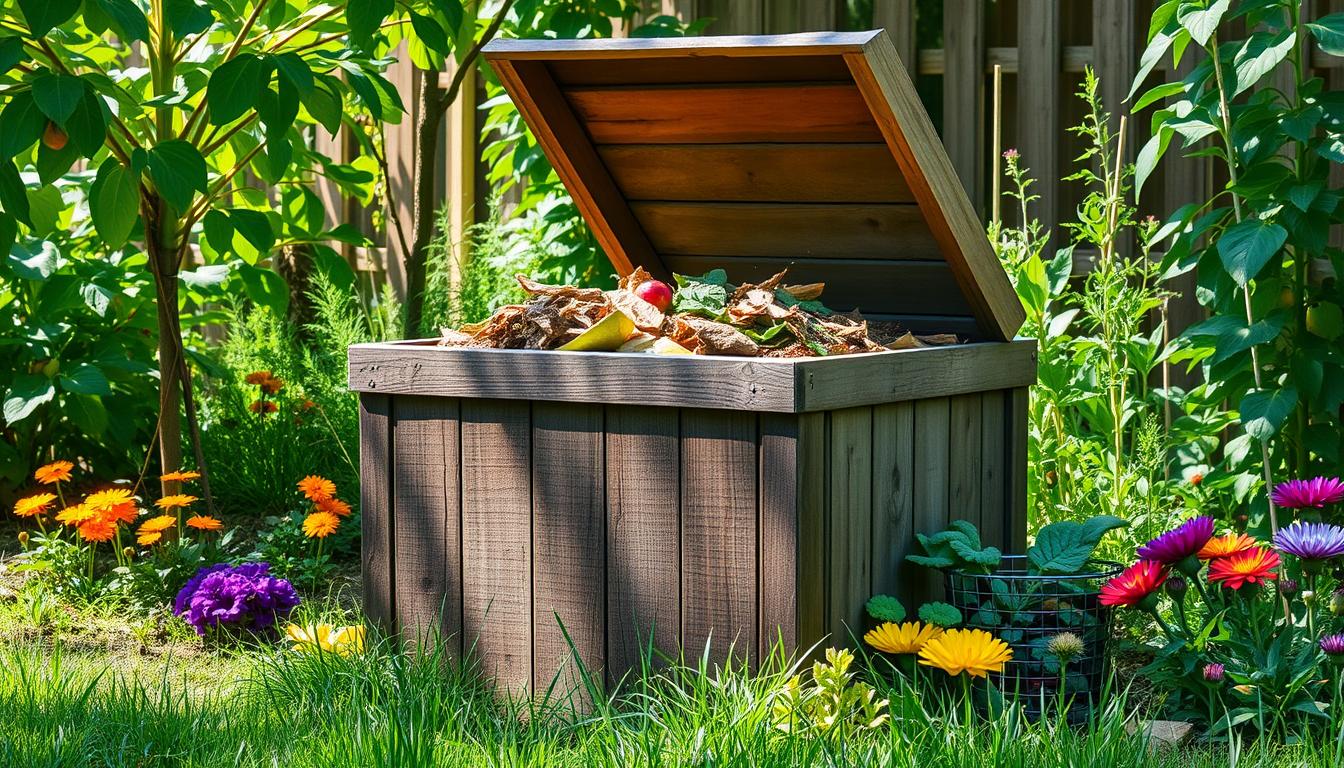
If you’re looking for a natural way to boost your lawn’s growth, composting in lawn care is a great solution.
Did you know that 30% of American landfills are filled with yard trimmings and food scraps?
Composting is a simple way to cut down on this waste. It also makes your lawn healthier and helps the environment. By using composting, many lawns stay green all year.
Compost is made from things like yard waste, manure, and food scraps that break down. Adding compost to your lawn in spring or fall gets it ready for growth. This not only feeds your grass but also helps the soil, prevents diseases, and saves water.
Key Takeaways
- Composting provides nutrient-rich organic material to improve soil health and prevent plant diseases.
- Compost helps in reducing the need for chemical fertilizers, promoting organic lawn care practices.
- Composting can significantly reduce methane emissions from yard waste in landfills.
- Compost improves soil structure, nutrient retention, and moisture retention, creating ideal growing conditions.
- Starting a compost pile is an easy and cost-effective way to reduce waste and enhance soil health.
What is Composting?
Composting in lawn care is an easy way to improve the health of your grass and soil.
Composting turns yard waste and food scraps into a nutrient-rich soil amendment called compost. This happens through the work of microorganisms, bacteria, and fungi. The compost is great for making your lawn, garden, and landscaping projects healthier.
Nutrient-Rich Organic Decomposition
The composting process breaks down organic materials into essential nutrients like nitrogen, phosphorus, and potassium. These nutrients are released as the materials decompose. Plants can then absorb them easily. This breakdown is thanks to a variety of microorganisms that thrive in compost piles.
Homemade or Store-Bought Compost
You can make compost at home or buy it. Homemade compost lets you recycle your own waste. Store-bought compost is handy for those without space or time for home composting. Both types can make your lawn healthier.
“Composting is a win-win for both the environment and your lawn. It’s a way to recycle organic waste while creating a nutrient-rich soil amendment that can help your grass thrive.”
Benefits of Composting for Lawns
By adding compost to your lawn, you’re practicing composting in lawn care and giving your plants the nutrients they need.
Composting is a game-changer for a lush, healthy lawn. Adding nutrient-rich compost to your grass brings many benefits. It can transform your outdoor space.
Supports Healthy Soil
Composting in lawn care helps create a stronger, more resilient lawn by improving soil structure.
Compost is a feast for your lawn’s roots. It provides essential nutrients like nitrogen, phosphorus, and potassium. These nutrients nourish the grass and encourage growth.
The organic matter in compost also improves soil structure. It balances pH levels and creates a great environment for beneficial microorganisms.
Prevents Lawn Diseases
A healthy, compost-enriched soil fights off common lawn diseases. Compost promotes the growth of beneficial bacteria and fungi. This helps prevent issues like red thread, leaf spot fungus, brown patches, and snow mold.
Your lawn will be more resilient and less prone to these problems.
Improves Water Retention
Compost acts as a natural water-holding sponge. It absorbs moisture and slowly releases it to your lawn’s roots. This reduces the need for frequent watering, saving time and money.
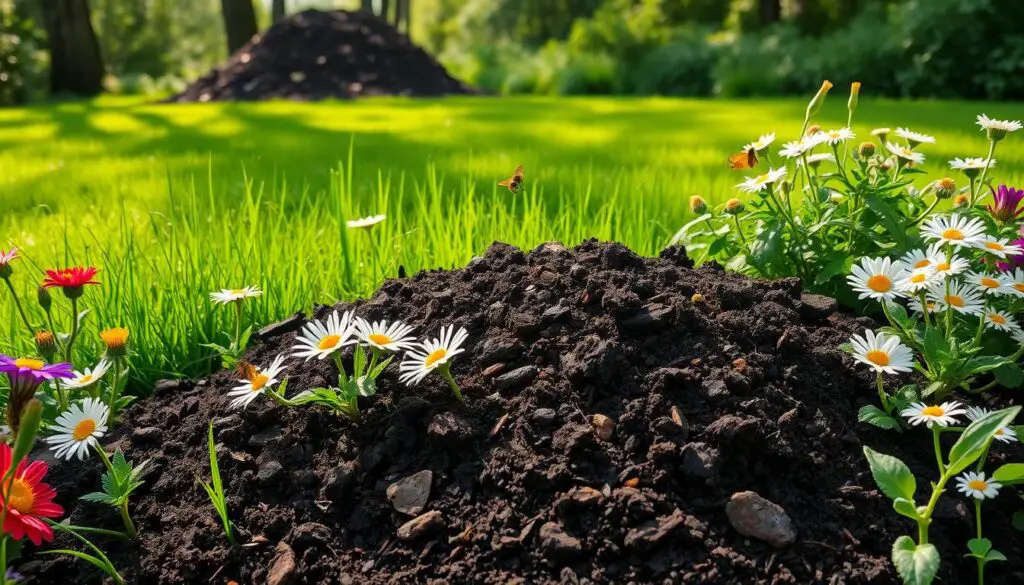
“Composting contributes to environmental sustainability by diverting organic waste from landfills and reducing the need for chemical fertilizers and insecticides.” – Sam, Mowers Guide author
By embracing composting, you can turn your lawn into a thriving, disease-resistant oasis. It requires less maintenance and water. Invest in your outdoor space’s long-term health and enjoy the benefits of compost-amended soil.
composting lawn care
Composting is a big deal for organic lawn care. It turns your lawn into a lush, green space. Compost adds nutrients to your grass and soil.
For compost to work best, it should be 5% of your lawn’s soil. It might take a few years, but it’s worth it. Compost gets hot, up to 160°F, because of all the tiny life in it.
Compost makes your soil better by improving air and water flow. It also helps prevent soil erosion. Plus, it holds onto water, so you don’t have to water as often. This helps your lawn stay healthy and strong.
Composting isn’t just good for your soil. It can also save you money. Compost gives your lawn nutrients slowly, so you don’t need to use chemical fertilizers. This makes lawn care cheaper and better for the planet.
Using compost can change your lawn care game. You can make your own compost or buy it. Either way, it makes your lawn green and saves you money. It’s a smart, eco-friendly choice for your lawn.
“Compost acts as a natural fertilizer, providing essential nutrients for your grass and soil.” – Sam, author of this blog
Reducing Lawn Care Time and Costs
Creating your own compost bin at home can save you a lot of money on lawn care. You won’t need to buy expensive fertilizers or herbicides. Composting also helps your soil hold water better, so you’ll use less water and save on your water bill.
Composting makes lawn care easier and cheaper. It gives your grass the nutrients it needs for a healthy look. This saves you time and money, and it’s good for the planet too!
| Benefit | Impact |
|---|---|
| Reduced fertilizer costs | Up to 25% of lawn’s fertilizer needs can be met by leaving grass clippings on the lawn |
| Decreased watering needs | Composting can reduce summer watering requirements by up to 50% for warm-season grasses |
| Less time spent mowing | Average mowing time can decrease by 30% when clippings are not bagged |
By using composting, you’ll cut down on lawn care time and costs. Your lawn will stay lush and healthy. It’s a smart choice for your wallet and the planet.
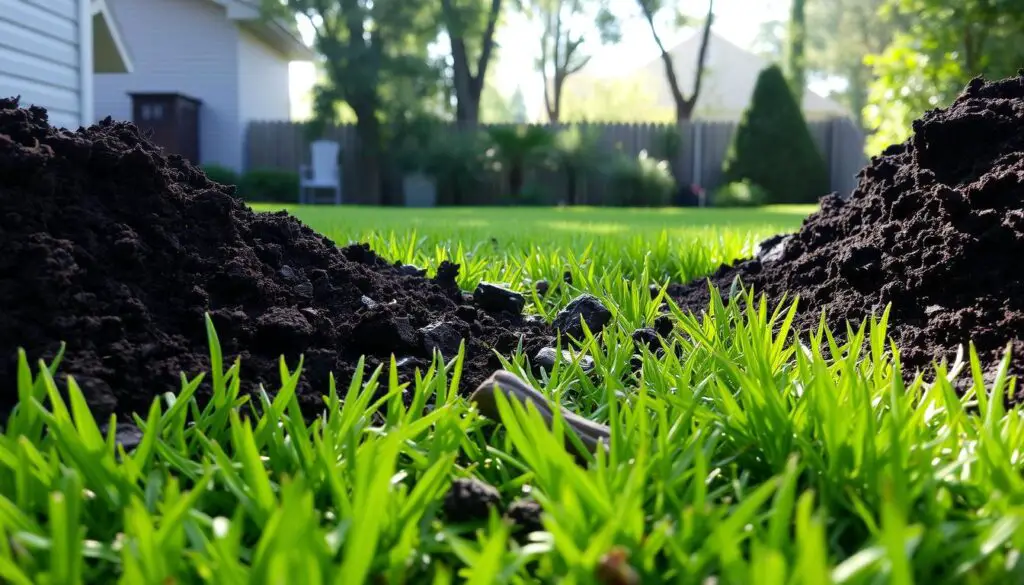
Environmental Benefits of Composting
One of the biggest benefits of composting in lawn care is its ability to reduce the need for chemical fertilizers.
Composting is a simple yet powerful way to reduce our environmental impact. It nourishes our lawns in a sustainable manner. By recycling yard waste, we return valuable organic matter to the earth. This feeds the nutrients our soil and plants need to thrive.
Yard Waste Recycling
Composting diverts organic materials from landfills, where they produce harmful methane. Instead, these materials are broken down into a nutrient-rich soil amendment. This amendment can be applied directly to our lawns and gardens.
This not only reduces waste but also helps build healthier, more fertile soil.
Reducing Chemical Fertilizer Need
One of the significant environmental benefits of composting is its ability to reduce our reliance on chemical fertilizers. By using nutrient-dense compost, we can nourish our lawns without the need for synthetic, potentially harmful products. This protects local water sources, wildlife, and the ecosystem from chemical runoff.
Studies show that just a light application of compost can improve fertilizer efficiency. It reduces the need for frequent applications. This allows us to enjoy lush, healthy lawns while minimizing our environmental footprint.
“Composting is a simple, effective way to turn yard waste into a beneficial soil amendment, reducing the need for chemical fertilizers and helping to build a healthier, more sustainable lawn.” – Richard, ecology and soil health specialist
By embracing composting, we contribute to the health of our local environment and the planet. It’s a win-win for our lawns and the broader ecosystem.
Creating a Compost Bin
Composting turns yard waste into soil that’s good for your lawn. But, where do you begin? Making your own compost bin is easy and saves money. You can use a container or pile method, but you need to pick the right spot and set it up right.
Choosing the Right Location
Find a hidden spot in your garden or backyard for your compost bin. It should be on bare soil, away from sun and wind. This keeps the compost moist and warm. Also, pick a spot that’s easy to get to but not too visible.
Container or Pile Method
You can make a compost bin in two ways: using a container or building a pile. The container method uses a big plastic bin or wooden box. Drill holes for air, and you’re set.
The pile method makes an open-air heap, about 3 x 3 feet. Start with a tarp, then add layers of brown and green materials. Use chicken wire to keep it in place.
No matter your choice, add pest control. Cover the top to keep animals out. This way, your compost turns into soil that’s good for your lawn.
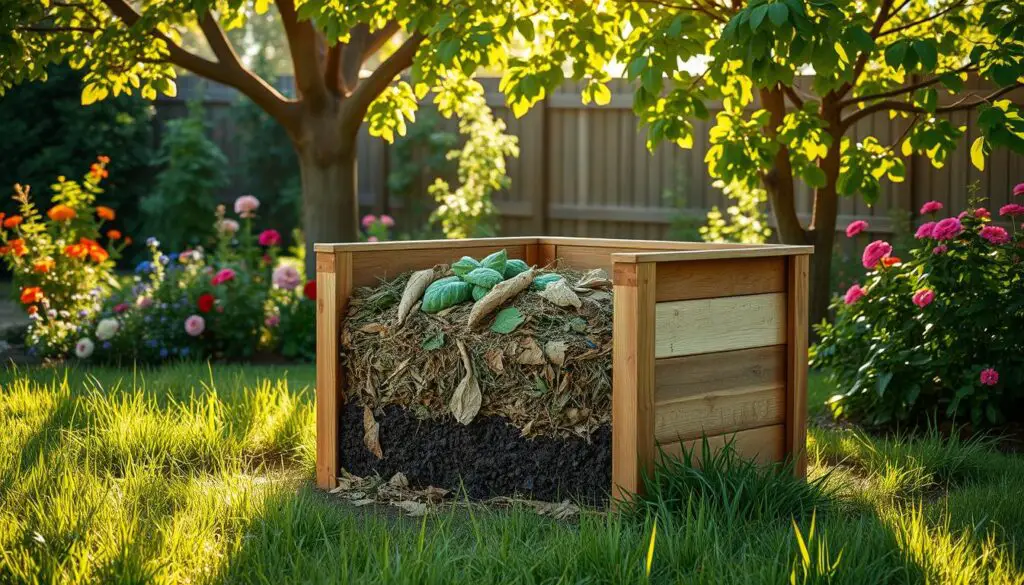
Maintaining Your Compost Bin
Keeping your compost bin healthy is key to getting rich soil for your lawn. As a gardener, I know that checking on your compost often is important. I turn the compost with a fork or shovel every week or so. This helps everything break down evenly and keeps it fresh.
It’s also important to keep the compost moist. I add water to keep it damp, like a sponge. If it gets too wet, I add dry leaves or newspaper to soak up the extra water and stop mold.
I aim for a compost bin height of 3.5 to 5 feet. A pile that’s too tall can squish the materials, making it hard to turn. For my shredded compost, I stick to 3.5 feet to keep it warm and moist.
| Composting Metric | Optimal Range |
|---|---|
| Compost Pile Height | 3.5 to 5 feet |
| Moisture Level | As moist as a wrung-out sponge (40-60%) |
| Decomposition Time | 1 month to 1 year (6 weeks under ideal conditions) |
By taking care of my compost bin, I get a lot of good soil for my lawn. This way, I can grow a healthy lawn without using harmful chemicals. It’s a great way to be eco-friendly and reduce waste.
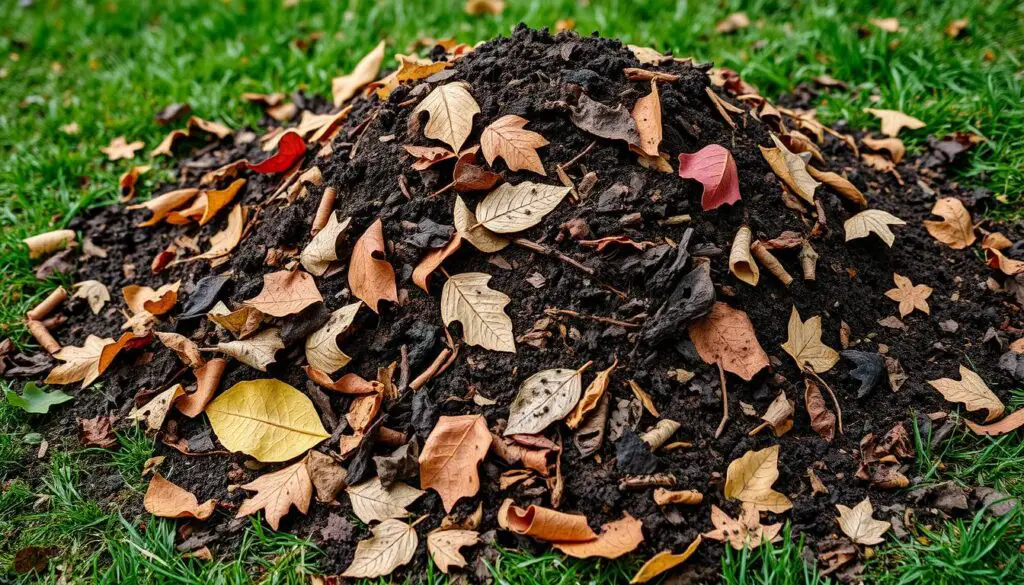
Using Compost for Lawn Care
Composting is a game-changer for a lush, vibrant lawn. It boosts your outdoor space’s beauty and sustainability. Top dressing and soil amendment are key ways to use compost.
After seeding, sprinkle compost as a top dressing. This encourages healthy grass growth. Doing this once or twice a year makes your lawn lush and vibrant. Compost acts as an organic fertilizer, providing essential nutrients.
Compost can also level lawns and help growth in tough spots. It improves soil structure, aeration, and drainage. This creates the perfect environment for your grass to thrive.
The Benefits of Compost for Lawn Care
- Compost has essential nutrients like nitrogen, phosphorus, and potassium for grass growth.
- It improves soil structure, increasing aeration and drainage for lush grass.
- Compost acts as a natural sponge, retaining moisture and releasing it slowly. This reduces frequent irrigation needs.
- It supports a thriving microbial community, promoting nutrient recycling and soil health.
- Compost gradually releases nutrients, reducing synthetic fertilizer use and runoff risk.
Using compost for lawn care makes your lawn greener and healthier. It also supports a sustainable, eco-friendly landscape. Say goodbye to patchy spots and hello to a lush lawn that’s the envy of the neighborhood.
Properly maintaining your lawn mower is crucial for a healthy lawn. Don’t let it fall victim to the elements. Ensure your mower is well-cared for and ready to tackle the job.
| Application Rate | Compost Needed |
|---|---|
| 1/4 inch depth | 1 cubic foot per 25 square feet of lawn |
| 1/2 inch depth | 1 cubic foot per 25 square feet of lawn |
A balanced approach is key for a lush, healthy lawn. This includes using compost, proper mowing, and maintenance. With effort, you can turn your outdoor space into a green oasis.
Native Plants for Eco-Friendly Landscaping
As an eco-conscious homeowner, I’ve found the joy of using native plants in my garden. They need less water and care than other plants. Plus, they offer food and homes for local wildlife, like pollinators and birds.
Native plants are great because they fit well with our local climate and soil. They use up to 50% less water than other plants. This helps save water and reduces waste by up to 30%.
- Native plants like Agastache, Penstemon, Ratibida, and Nepeta add color and texture to your garden.
- They create homes for birds, butterflies, and other pollinators, helping to keep our biodiversity strong.
- Native plants need less care, like fewer fertilizers and pesticides, making them better for the environment.
When thinking about changing your garden, look into native plants for your area. They make your garden beautiful and help the local ecosystem. It’s good for you and the planet!
“Native plants are the foundation of a healthy, vibrant ecosystem, providing food and shelter for countless species of wildlife.”
Expanding Garden Beds to Reduce Lawn
As a homeowner, I’ve learned that a big lawn isn’t always the best. By growing my garden beds and cutting down on lawn, I’ve made my yard more diverse and green. It looks great and offers many benefits.
I started by turning almost 1000 square feet of lawn into garden beds. In mid-May, I planted a mix of perennials, annuals, and grasses. Plants like dotted horsemint and purple coneflower made the garden lively and full of life.
“As the garden grew, I needed to weed very little. This let me focus on keeping the garden healthy and looking good. In the fall, I added compost to the soil to get ready for next year’s growth.” – Sam, author
The first year was a huge success. The partridge pea was a hit, drawing many bees. I made sure the garden had both sunny and shady spots for different plants to grow well.
Changing my lawn into a garden was easy, taking just 5+ hours. The cost varied based on the plants, but the benefits of less lawn care and more biodiversity were worth it.
| Aspect | Details |
|---|---|
| Soil Tillage Depth | 8-12 inches |
| Recommended Slope | 1/4 inch per foot |
| Planting Hole Depth | 2-3 times root ball width |
| Mulch Layer Thickness | 2-3 inches |
| Compost Depth for No-Dig Beds | 5cm (2″) |
| Compost Price (example) | £30 for 5 tonnes |
| Compost Usage per Square Meter | Around 60 liters |
| Bed Width | 1.2m (4ft) |
| Path Width | 30cm (12″) |
| Annual Mulch for Beds | Around 2cm (under 1″) |
By making my garden bigger and lawn smaller, I’ve made my yard prettier and better for the planet. It also saves me a lot of time and effort. This change has been very rewarding, and I’m looking forward to seeing my garden grow even more in the future.
Fall Leaf Composting Tips
As leaves fall, think about turning them into compost for your lawn and garden. Composting leaves is a green way to cut down on yard waste. It also makes soil rich in nutrients. Here are some tips to use your fallen leaves wisely:
- Shred the leaves with a lawn mower to speed up the decomposition process. Shredded leaves break down faster and are less likely to mat together.
- Aim for a balanced carbon-to-nitrogen ratio in your compost pile. Leaves are a “brown” carbon-rich material, so you’ll want to add some “green” nitrogen-rich ingredients like fresh grass clippings or vegetable scraps.
- Avoid adding leaves from black walnut or eucalyptus trees, as they can inhibit plant growth. Also, don’t use leaves from plants treated with weed killers or other chemicals.
- Turn the compost pile every two weeks to aerate the materials and promote even decomposition.
With a bit of effort, your fall leaves can be a great resource for your lawn and garden. The compost will feed your soil, making plants healthier and reducing the need for chemical fertilizers. Start your fall leaf composting today!
| Leaf Composting Tips | Benefits |
|---|---|
| Shred leaves with a mower | Accelerates decomposition |
| Balanced carbon-to-nitrogen ratio | Promotes healthy compost |
| Avoid certain leaf types | Prevents inhibiting plant growth |
| Turn compost pile regularly | Ensures even decomposition |
By composting your fall leaves, you’ll not only reduce waste but also create a valuable soil amendment. It’s a simple yet effective way to care for your lawn and garden sustainably. Start today and enjoy the benefits of your homemade leaf compost all year.
Learn More About Organic Lawn Care
If you want to switch to eco-friendly lawn care, there are many resources to help. OrganicLawns offers services for all kinds of landscaping needs. Whether your lawn is dying, full of weeds, or needs better soil, they can help.
Their team of experts will give you personalized advice. They’ll guide you to a lush, vibrant lawn using natural methods.
Organic lawn care starts with healthy soil. It’s key for a low-maintenance lawn. By avoiding synthetic fertilizers and pesticides, you protect the environment and your family’s health.
There are many effective organic strategies to try. You can use compost and natural weed control methods.
Whether you do it yourself or hire a pro, learning about organic landscaping is rewarding. Switching to organic practices makes your lawn beautiful and helps the planet.
FAQ
What is composting and how can it benefit my lawn?
Can I make my own compost at home?
How do I maintain my compost bin or pile?
How do I apply compost to my lawn?
What are the environmental benefits of composting?
How can I transition my lawn to be more sustainable?
Where can I learn more about organic lawn care?
Source Links
- https://www.groundsguys.com/blog/2018/march/the-benefits-of-adding-compost-to-your-lawn/
- https://www.bvtrashvalet.com/sustainable-lawn-care-how-composting-can-improve-your-garden-and-reduce-waste/
- https://www.lawnstarter.com/blog/lawn-care-2/composting-101-how-to-start-your-first-compost-pile/
- https://executivelawncare.net/2020/03/16/everything-you-need-to-know-about-compost/
- https://extension.uga.edu/publications/detail.html?number=C816&title=composting-and-mulching
- https://www.greenerlawn.com.au/5-benefits-adding-compost-lawn/
- https://alliancelandscaping.com/blog/what-is-compost-and-why-is-it-so-beneficial-for-your-lawn
- https://www.wikilawn.com/lawn-care/benefits-composting-lawn/
- https://www.thespruce.com/compost-for-the-lawn-2152935
- https://golfcourselawn.store/blogs/diy-lawn-care/can-you-put-compost-on-your-lawn?srsltid=AfmBOoqXgPJy51dImM_RTZHMnsESZCbgYfNUxR-Ai1AaFy1Lo1Lgjs_L
- https://extension.missouri.edu/publications/g6959
- https://lawntolakemidwest.org/in-the-weeds/build-healthy-soil/add-nutrients-and-organic-matter/
- https://www.mogalixe.com/blog/the-importance-of-composting-and-its-benefits-to-the-lawn-and-garden/
- https://hlcfert.com/blog/What-are-the-benefits-of-compost-for-your-lawn
- https://lawnlove.com/blog/diy-compost-bin/
- https://www.botanicgardens.org/blog/start-backyard-compost-bin
- https://aggie-horticulture.tamu.edu/earthkind/landscape/dont-bag-it/chapter-4-building-and-maintaining-a-compost-pile/
- https://freckledcalifornian.com/2020/05/22/how-to-compost-filling-maintaining-a-compost-bin/
- https://www.milorganite.com/blog/Lawn/how-naturally-feed-your-lawn-topdressing-compost
- https://golfcourselawn.store/blogs/diy-lawn-care/can-you-put-compost-on-your-lawn?srsltid=AfmBOoov0Sf2RtzuEGwmZltjUN_Q3YjxzQMF5Ie9YL0-OQYhuQKY4vhj
- https://www.freestatefarmsva.com/post/how-do-i-topdress-my-lawn-with-compost?srsltid=AfmBOopcDWJ3OjxkFK-0DCI5RtxhCIvqS1H9wRNlCZ4xHnglWFUUDjwQ
- https://www.myattlandscaping.com/blog/cultivating-green-sustainable-landscaping-practices-113
- https://henderson.ces.ncsu.edu/2024/07/environmentally-friendly-landscaping/
- https://www.highcountrygardens.com/content/gardening/native-plants-landscaping-for-water-conservation
- https://www.ecolandscaping.org/04/designing-ecological-landscapes/native-plants/lawn-murder/
- https://www.thisoldhouse.com/gardening/22231112/how-to-clean-up-and-expand-a-garden
- https://nodighome.com/2021/05/23/making-no-dig-beds-on-lawn-the-card-and-compost-method/
- https://www.familyhandyman.com/list/tips-for-composting-leaves/
- https://www.earth-smart-solutions.com/blogs/blog/the-practical-benefits-of-fall-leaves-composting-mulching-and-yard-care-tips
- https://www.jonathangreen.com/resources/how-to-make-leaf-compost/?srsltid=AfmBOopW-Pb3gLqOOc4K98rkK3xAEhchQASo-pnNNosvyW_KaSqb-AIO
- https://www.forbes.com/home-improvement/lawn-care/organic-lawn-care-guide/
- https://www.milorganite.com/blog/Lawn/five-steps-organic-lawn

